| . |
Short-haired
Cats
.
Long-haired
cats
.
Cat
family

|
. |
. |
 |
Short-haired
Cats |
|
Domestic CATS belong to
either the longhair or the shorthair categories. Although longhaired
cats are prized for their showy appearance, shorthaired cats do not require
as much grooming, and shedding of hair presents less of a problem.
Particular breeds of shorthairs
include the Siamese, the Abyssinian, and the Burmese cats. The Siamese
has very short hair and blue, slightly crossed eyes. Its evenly colored
coat is marked by points--darker patches of color on its face, ears, paws,
and tail. The Abyssinian, which resembles cats depicted in ancient
Egyptian art, is a large, slender cat with a ticked reddish coat--that
is, each hair has two or three distinct bands of color. The Burmese,
partly bred from Siamese during the 1930s, is a show breed of medium size
and rich, sable brown color.
.
 |
Abyssinian
cat |
. |
|
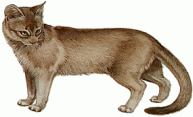
|
The Abyssinian
cat, a short-haired breed of domestic cat, is believed to be related to
the cats depicted in ancient Egyptian art. |
| . |
. |
. |
 |
Siamese
cats |
. |
|
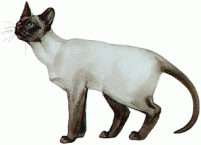
|
Siamese
cats, a popular breed of shorthaired domestic cat, are small but muscular
and agile, with a wedge-shaped head, slim legs, and a long, narrow tail.
Their slanted blue eyes may be crossed, and they possess a range of striking
cries. Born partially albino, grayish cream in color, most Siamese develop
"points," or darker colors, on their tail, muzzle, ears, legs, and feet:
red (red point), dark brown (seal point), light brown (chocolate point),
blue, gray, or lilac with a pink cast (lilac point). |
| . |
. |
. |
 |
Lynx-point |
. |
|
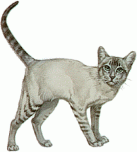
|
The lynx-point, or tabby-point,
shorthaired cat is one of three varieties of colorpoints. The colorpoint
cat was developed from the Siamese and the domestic cats. |
|
 |
Long-haired
cats |
|
All longhaired cats are
frequently, but incorrectly, called Persian or Angora cats because two
of the oldest and best-known types are known by those names. The Persian-type
longhair is believed to have originated in Persia (Iran), but the evidence
is inconclusive. A Persian-type longhair has a short, compact body, a short
tail, and a large, rounded head with a short nose and small ears. Persian
cats, officially called longhairs in Britain, are bred in a wide variety
of colors and patterns. The Angora-type longhair is believed to have originated
in Turkey or possibly Armenia. It is finer-boned and with longer body,
legs, and tail, smaller head, and larger ears than the Persian, and its
coat is not as long and dense. White is at present the only accepted Angoran
coat color in America.
.
 |
Maine
coon cat |
. |
|
 |
The Maine coon cat is one
of the oldest American breeds and is probably descended from long-haired
Angora cats brought to New England by seamen.These Angoras randomly interbred
with local short-haired cats and established the breed type.Some early
settlers thought that the cat was part raccoon. The Maine coon cat is large,
some weighing over 13.5 kg (30 lb). Its coat, which may be any color, is
long and lies close to the body instead of away from it, as in Persian
cats. |
| . |
. |
. |
 |
Himalayan
cat |
. |
|

|
The Himalayan cat is a crossbreed
that combines the body shape and long hair of the Persian cat with the
coloration of the Siamese. |
| . |
. |
. |
 |
Angora
Cat |
. |
|

|
The term Angora cat once
referred to a particular breed of long-haired cat thought to have originated
in Turkey.By the 19th century, however, specific Angora characteristics
had disappeared as Angoras were interbred with Persian cats. Persian then
was used as the nomenclature for all long-haired cats.The Turkish Angora,
a relatively new breed in the West, has been imported from Turkey and bred
since 1953. It has a wedge-shaped head, silky white hair, and blue
or amber eyes. |
|
 |
Cat
Family |
|
The cat family, Felidae,
order CARNIVORA, contains about 36 species that are usually grouped into
two to four genera, depending on the classification system used.
According to one common system, four genera exist: Panthera (JAGUAR,
LEOPARD, LION, TIGER), Neofelis (clouded leopard),
Acinomyx (CHEETAH), and Felis (PUMA, LYNX, and smaller
cats such as the domestic CAT, PALLAS'S CAT, and the WILDCAT). Cats
are native to all continents except Australia and Antarctica.
Cats have short, rounded
heads, erect ears, and large eyes with vertical-slit pupils. The pupils
are considered adaptations for nocturnal existence. There are 28 to 30
teeth, depending on the species. The canines, or fangs, are large and strong
and used for stabbing prey. The carnassials, a pair of teeth on each side
of the jaw--the last upper premolar and the first lower molar--are formed
into large, cross-shearing blades for cutting meat. The tongue is covered
with sharp, curved projections (papillae) used for rasping meat off bones,
cleaning the fur, and drinking. The neck is thick and heavy to withstand
the shocks of the violent actions of the head and teeth.
Cats have five toes on each
front foot and four toes on each hind foot and are known as digitigrade,
that is, they walk on the anatomical equivalent of human finger- and toe-tips;
the fifth digit, or thumb (dewclaw), is carried high on the leg. All cats
except the cheetah have large, curved, sharp claws to hold their prey.
These claws can be retracted into sheaths on the toes to prevent them from
becoming blunted. The cheetah has less-developed, only partially retractile
claws. Many cats walk by placing the hind feet in the tracks of the forefeet.
Most cats are crepuscular
(active at twilight) or nocturnal and hunt by stealth, either lying in
wait or silently stalking the prey until close enough to catch it with
a short burst of great speed. The cheetah, the fastest four-legged animal,
runs down its prey in an overland chase.
Cats range from 50 cm to
3.75 m (20 in to 12.3 ft) in combined head and body length, excluding the
tail, and from 2.5 to 275 kg (5.5 to about 600 lbs) in weight. Most cats
have one or two litters a year, but some of the larger cats may breed only
once in 2 or 3 years. Litters average one to six young, which are usually
born blind but covered with hair. Cats may be solitary, live in pairs,
or associate in family groups.
Cats evolved from viverrid
(civet) ancestors during the late Eocene (about 45 million years ago);
by the early Oligocene (about 35 million years ago), they were not very
different from the modern, highly developed cat.
One branch of the cat family,
however, which became extinct at the end of the Pleistocene (about 100,000
years ago), was the saber-toothed cat. In the saber-tooths, the upper
canines became very large and elongated.
.
 |
The
Jaguar |
. |
|
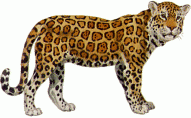
|
The jaguar, P. onca, the
largest cat found in the Americas, looks like a leopard but is more heavily
built. The solitary jaguar establishes its own territory, and males
and females disregard each other except during the mating season. |
| . |
. |
. |
 |
The
Puma |
. |
|
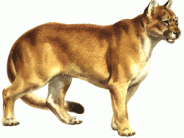
|
The puma, P. concolor, a
large North American cat, ranges from southern Canada to South America.
This solitary cat has been hunted by farmers and ranchers because it sometimes
attacks livestock. |
| . |
. |
. |
 |
The
Lion |
. |
|
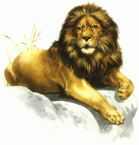
|
The lion, P. leo, usually
hunts in groups, one lion driving prey toward other lions lying in wait.
The adult male (shown) often takes no active role in the hunt but nevertheless
will claim his portion of the kill. Common throughout central Africa, lions
are in danger of extinction in India. |
|

|

